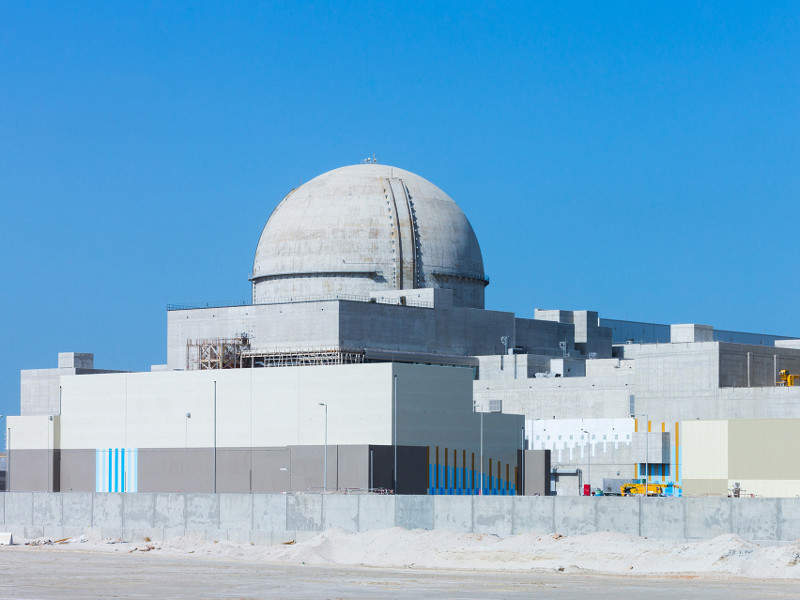The 5.6GW Barakah nuclear power plant (NPP) under construction in the Dhafra Region of Abu Dhabi is the first nuclear power project in the United Arab Emirates (UAE) as well as in the entire Arab world.
The project is being jointly developed by Emirates Nuclear Energy Corporation (ENEC) and the reactor supplier Korea Electric Power Corporation (KEPCO). It is located approximately 53km west-southwest of the city of Ruwais.
Nawah Energy Company, a joint venture formed by ENEC and KEPCO in 2016, is responsible for the operation and maintenance of the NPP.
Construction on the £19bn ($24.4bn) nuclear power project started in July 2012. The first of the four 1.4GW reactors of the NPP was connected to the grid in August 2020, while the second unit commenced commercial operations in September 2021.
The Barakah-3 and Barakah-4 reactor units are in the final stages of commissioning with construction 95% and 91% complete, respectively, as of September 2021.
The Barakah NPP is expected to serve a quarter of UAE’s total electricity demand while offsetting more than 21 million tonnes (Mt) of greenhouse emissions a year, when fully operational.
Barakah nuclear power plant development history
The site preparation license application for the Barakah NPP was submitted to FANR in April 2010. The official groundbreaking ceremony was held in March 2011.
ENEC applied for the construction licence for units 1 and 2 in December 2010 and received approval for the same from FANR in July 2012.
The construction licence application for units 3 and 4 was submitted in February 2013, which was approved in September 2014.
The operating licence application (OLA) for units 1 and 2 was filed in March 2015, while that for units 3 and 4 was filed in May 2017.
Nawah secured the operating licences for Barakah-1 and Barakah-2 from UAE’s Federal Authority of Nuclear Regulation (FANR) in February 2020 and March 2021, respectively.
Barakah nuclear reactor details
The Barakah nuclear power plant will be equipped with four APR1400 reactor units of 1,400MW gross electric capacity each.
APR1400 is an advanced pressurised water reactor (PWR) based on the well-proven Korean Standard Nuclear Power Plant (KSNP) design.
Developed by the Korean nuclear industry under the leadership of KEPCO, the APR1400 technology is based on the System 80+ design, which is certified by the US Nuclear Regulatory Commission (NRC).
The reactor is licenced by the Korea Institute of Nuclear Safety (KINS) and has an estimated operational lifespan of 60 years.
Electricity transmission
Electricity generated from the Barakah NPP is evacuated and fed into the UAE grid by Abu Dhabi Transmission and Despatch Company (TRANSCO).
ENEC signed a connection and interface agreement for the same with TRANSCO in February 2016.
Financing for Barakah NPP
Financial closure for the £19bn ($24.4bn) nuclear power plant was achieved in October 2016. The project is being financed through 80% debt and 20% equity.
The debt financing comprises £13.3bn ($16.2bn) of direct loan from the Abu Dhabi government and a £2bn ($2.5bn) loan facility from the Export-Import Bank of Korea (KEXIM).
Contractors involved
A consortium led by KEPCO was awarded a £12.8 ($20.4bn) contract for the design, construction, and operation of four APR1400 reactor units at the Barakah NPP in December 2009.
The other members of the consortium include Korea Hydro & Nuclear Power (KHNP), Hyundai, Samsung, Doosan, Korea Power Engineering Company (KOPEC), Korea Nuclear Fuel (KNF), and Korea Plant Service and Engineering (KPS).
KHNP is responsible for the operating support services and co-operative businesses, while KEPCO Engineering & Construction (KEPCO E&C) was subcontracted for the plant design, architecture, and engineering works.
Bechtel was engaged to provide design and project management support services to KEPCO E&C.
Doosan is in charge of the construction and management of the nuclear steam supply system (NSSS), steam generator, and other related components.
Toshiba Energy Systems & Solutions (Toshiba ESS) was subcontracted by Doosan to design and manufacture steam turbine, generator, and auxiliary equipment of the Barakah-1 generating unit. Toshiba also supplied 80kA 400kV gas circuit switchgear and related equipment to KEPKO for the switchyard of the Barakah NPP.
Hyundai and Samsung were entrusted with the civil engineering works, while Westinghouse was subcontracted for providing technical assistance and license-related works.
The nuclear fuel for the Barakah NPP will be supplied by KNF and maintained by KPS.
Hilal Bil Badi and Partners Contracting (HILALCO), a local company, was awarded the engineering, procurement, and construction (EPC) contract for the critical water intake structures of the plant.
Other major local firms involved with the project include Emirates Steel, National Cement, Dubai Cable Company, National Marine Dredging Company, and Western Bainoona Group.
Nawah Energy signed a ten-year operation and maintenance (O&M) framework agreement with EDF for the Barakah NPP, in November 2018.






